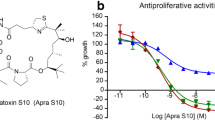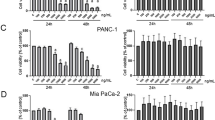Summary
Adenocarcinoma of the pancreas presents a formidable challenge both experimentally and clinically, whereby effective anticancer therapy is lacking. We have recently explored a relatively new class of antitumor agents in pancreatic cancer cell lines and have found the bis-ethyl derivatives of spermine to show considerable promise. In the present paper, we report the results of in vivo studies demonstrating the antitumor activity of two of theseN-alkylated analogues,N 1,N 14-bis(ethyl)norspermine (BENSPM) in athymic (nude) mouse xenografts of two human pancreatic ductal adenocarcinoma cell lines, PANC-1 (poorly differentiated) and BxPC-3 (moderately well-differentiated). BENSPM was found to exert greater antitumor activity in vivo than either BEHSPM or other conventional agents, largely because higher doses could be given due to its lower toxicity to mice. BENSPM shows greater activity than any other agent we have thus far tested against our pancreatic-cancer models. Optimal schedules of administration have yet to be determined. Nevertheless, of the analogues tested, BENSPM presently appears to be the analogue of choice for further development.
Similar content being viewed by others
References
Basu HS, Feuerstein BG, Deen DF, Lubich WP, Bergeron RJ, Samejima K, Marton LJ (1989) Correlation between the effects of polyamine analogues on DNA conformation and cell growth. Cancer Res 49:5591–5597
Bergeron RJ, Garlich JR, Stolowich NJ (1984) Reagents for the step-wise functionalization of spermidine, homospermidine, and bis-(3-aminopropyl)-amine. J Org Chem 49:2997–3001
Bergeron RJ, Hawthorne TR, Vinson JRT, Beck DE Jr, Ingeno MJ (1989) Role of the methylene backbone in the antiproliferative activity of polyamine analogues on L1210 cells. Cancer Res 49: 2959–2964
Reference deleted
Bernacki RJ, Bergeron RJ, Porter CW (1992) Antitumor activity ofN,N′-bis(ethyl)spermine homologs against human MALME-3 melanoma xenografts. Cancer Res (in press)
Casero RA Jr, Celano P, Ervin SJ, Porter CW, Bergeron RJ, Libby PR (1989) Differential induction of spermidine/spermineN 1-acetyltransferase in human lung-cancer cells by the bis(ethyl)polyamine analogues. Cancer Res 49:3829–3833
Chang BK, Black O Jr, Gutman R (1984) Inhibition of growth of human or hamster pancreatic cancer cell line by α-difluoromethylornithine alone and combined withcis-diamminedichloroplatinum(II). Cancer Res 44:5100–5104
Chang BK, Gutman R, Black O Jr (1986) Combined effects of α-difluoromethyl-ornithine and doxorubicin against pancreatic cancer cell lines in culture. Pancreas 1:49–54
Chang BK, Gutman R, Chou T-C (1987) Schedule-dependent interaction of α-difluoromethylornithine andcis-diamminedichloroplatinum(II) against human and hamster pancreatic cancer cell lines. Cancer Res 47:2247–2250
Chang BK, Libby PR, Bergeron RJ, Porter CW (1988) Modulation of polyamine biosynthesis and transport by oncogene transfection. Biochem Biophys Res Commun 157:264–270
Chang BK, Porter CW, Bergeron RJ (1991) Cellular responses to polyamine analogues and inhibitors in human pancreatic adenocarcinoma cell lines. J Cell Pharmacol 2:133–137
Chang BK, Bergeron RJ, Porter CW, Vinson JRT, Liang Y, Libby PR (1992) Regulatory and antiproliferative effects ofN-alkylated polyamine analogues in human and hamster pancreatic-adenocarcinoma cell lines. Cancer Chemother Pharmacol 30:183–188
Connolly MM, Dawson PJ, Michelassi F et al (1987) Survival in 1001 patients with carcinoma of the pancreas. Ann Surg 206: 366–373
Corbett TH, Roberts BJ, Leopold WR, Peckham JC, Wilkoff LJ, Griswold DP Jr, Schabel FM Jr (1984) Induction and chemotherapeutic response of two transplantable ductal adenocarcinomas of the pancreas in C57BL/6 mice. Cancer Res 44:717–726
Douglass HO (1987) Pancreatic cancer: nihilism is obsolete! Pancreas 2:230–232
Gastrointestinal Tumor Study Group (1985) Radiation therapy combined with Adriamycin or 5-fluorouracil for the treatment of locally unresectable pancreatic carcinoma. Cancer 56:2563–2568
Gastrointestinal Tumor Study Group (1987) Further evidence of effective adjuvant combined radiation and chemotherapy following curative resection of pancreatic cancer. Cancer 59:2006–2010
Lieber M, Mazzetta JA, Nelson-Rees W, Kaplan M, Todaro G (1975) Establishment of a continuous tumor-cell line (PANC-1) from a human carcinoma of the exocrine pancreas. Int J Cancer 15: 741–747
Loor R, Nowak NJ, Manzo ML, Douglass HO, Chu TM (1982) Use of pancreas-specific antigen in immunodiagnosis of pancreatic cancer. Clin Lab Med 2:567–578
Pegg AE, Wechter R, Pakala R, Bergeron RJ (1989) Effect ofN 1,N 12-bis(ethyl)-spermine and related compounds on growth and polyamine acetylation, content, and excretion in human colon tumor cells. J Biol Chem 264:20
Pegg AE, Pakala R, Bergeron RJ (1990) Induction of spermidine/spermineN 1-acetyltransferase activity in Chinese-hamster ovary cells byN 1,N 11-bis(ethyl)norspermine and related compounds. Biochem J 267:331–338
Porter CW, Ganis B, Libby PR, Bergeron RJ (1991) Correlations between polyamine analogue-induced increases in spermidine/spermineN 1-acetyltransferase activity, polyamine pool depletion, and growth inhibition in human melanoma cells lines. Cancer Res 51: 3715–3720
Rockwell SC, Kallman RF, Fajardo LF (1972) Characteristics of a serially transplanted mouse mammary tumor and its tissue-culture adapted derivative. J Natl Cancer Inst 49:735–747
Author information
Authors and Affiliations
Additional information
This investigation was supported by grant CH-468 from the American Cancer Society, by grant CA-37 606 from the National Cancer Institute, Department of Health and Human Services, and by the Department of Veterans Affairs Medical Research Service
Rights and permissions
About this article
Cite this article
Chang, B.K., Bergeron, R.J., Porter, C.W. et al. Antitumor effects ofN-alkylated polyamine analogues in human pancreatic adenocarcinoma models. Cancer Chemother. Pharmacol. 30, 179–182 (1992). https://doi.org/10.1007/BF00686308
Received:
Accepted:
Issue Date:
DOI: https://doi.org/10.1007/BF00686308




